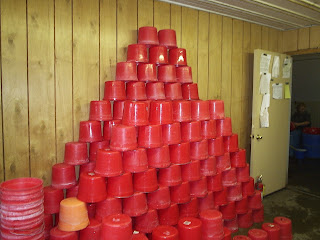Post-Wash Bacteria Growth
Question: When is clean not clean?
Answer: When we fail to allow just washed equipment to drain and dry!
Have in your mind's eye a stack of clean 10-quart calf feeding pails. All washed carefully with a detergent solution. Then, they were stacked up one inside another for about 15 pails.
I used the Hygiena SystemSure Plus unit to do adenosine
triphosphate (ATP) monitoring. The ATP test is a process of rapidly measuring
actively growing microorganisms through the detection of adenosine
triphosphate. An ATP monitoring system can detect the amount of bacteria that remains after cleaning a surface (for example, calf feeding
equipment).
The top pail that was allowed to air dry tested 43 (I use a threshold of 50 for calf feeding equipment as an acceptable level of contamination).
The next to the bottom pail (not allowed to dry - sat in stack for two days) tested 1,764.
Now, that is an increase we can all recognize as undesirable.
All that was needed to minimize bacteria regrowth was allowing the clean pails to drain and air dry.
The client agreed that they had a number of pails that needed to be thrown out. They could be set upside down on the floor. The washed pails could be set upside down on them to drain and air dry - no capital investment involved.
The picture shows this method (on a different dairy but the same idea).
Mark the pails that remain on the bottom row some way so they do not get picked up as "clean" pails - see the "X" marking on these.
Here are all the clean pails draining and air drying.



No comments:
Post a Comment